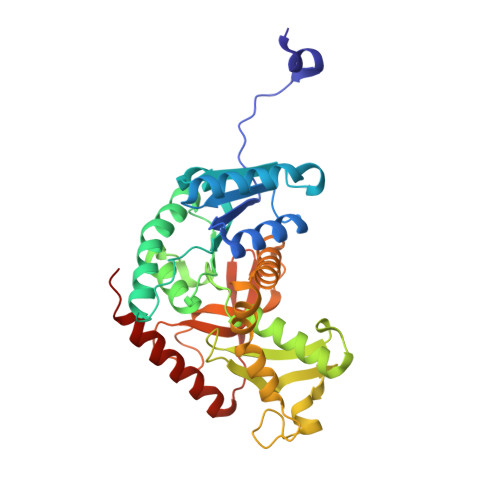Modeling of isotope effects on binding oxamate to lactic dehydrogenase
Swiderek, K., Panczakiewicz, A., Bujacz, A., Bujacz, G., Paneth, P.(2009) J Phys Chem B 113: 12782-12789
- PubMed: 19715328
- DOI: https://doi.org/10.1021/jp903579x
- Primary Citation of Related Structures:
3H3F - PubMed Abstract:
A new crystal structure of the rabbit muscle L-lactic dehydrogenase (PDB code 3H3F) has been determined. The independent unit of this structure contains two tetramers, each of them with a unique constitution of two active sites with the open loop conformation and two with the loops closed over the actives sites. On the basis of this structure, interactions of an inhibitor, oxamate anion, with the protein have been modeled using different hybrid schemes that involved B3LYP/6-31++G(d,p) DFT theory level in the QM layer. In ONIOM calculations, either Amber (QM:MM) or one of the three semiempirical parametrizations, AM1, PM3, and RM1 (QM:QM) was used, while in the traditional QM/MM scheme, the OPLS-AA force field was used for the outer layer. Normal modes of vibrations of oxamate in aqueous solution and in the active site of the enzyme were used to calculate binding isotope effects. On the basis of the comparison of the values obtained theoretically with those experimentally determined for the oxygen atoms of the carboxylic group of oxamate it was concluded that the DFT/OPLS-AA scheme, applied to the dimer consisting of two chains, one with the open loop and the other with the closed loop conformation, provides the best description of the active site. Calculations of the binding isotope effects of the other atoms of oxamate suggest that nitrogen isotope effect may be useful for the experimental differentiation between open and closed loop conformations.
- Institute of Applied Radiation Chemistry, Technical University of Lodz, ul. Zeromskiego 116, 90-924 Lodz, Poland.
Organizational Affiliation:



















